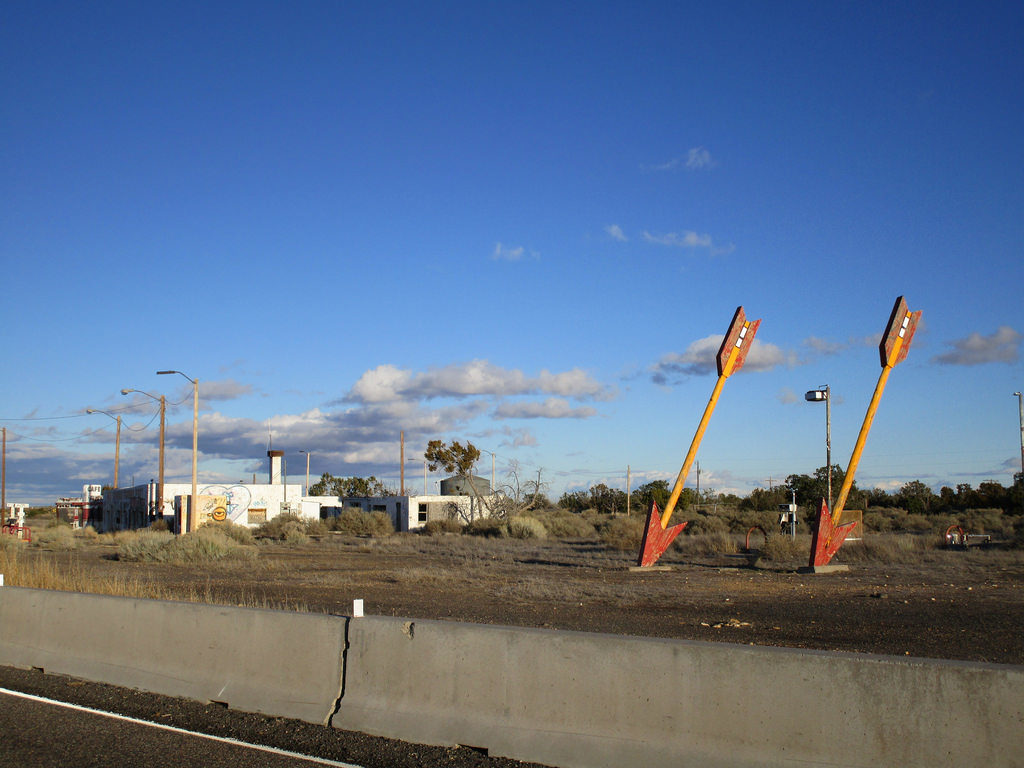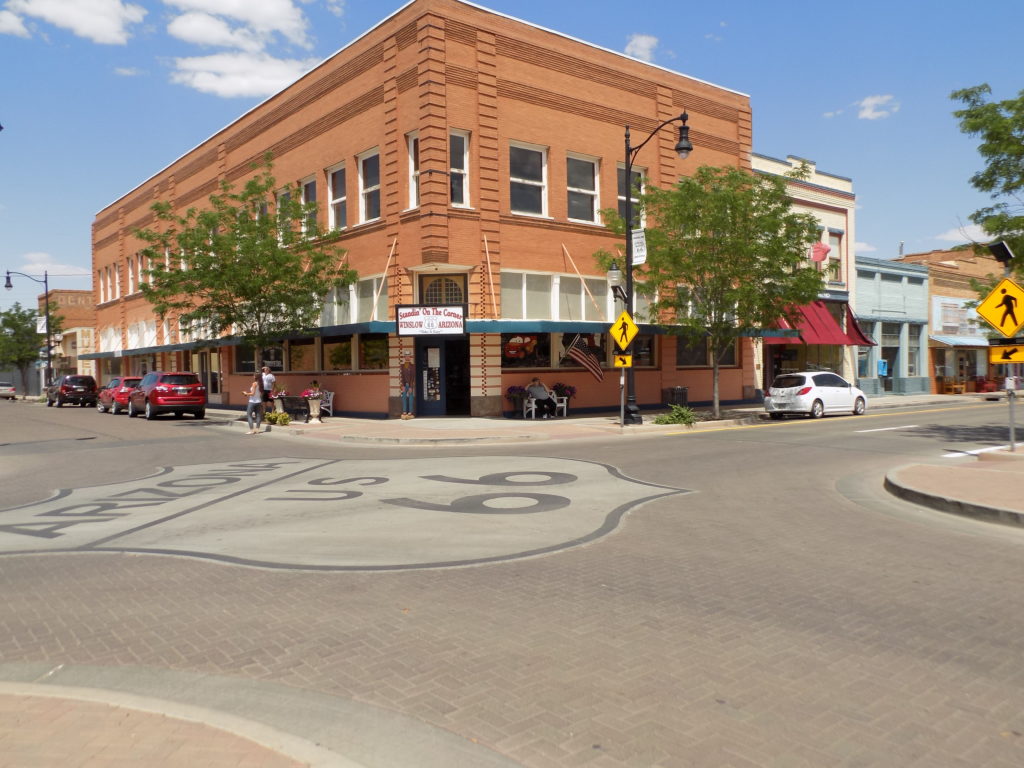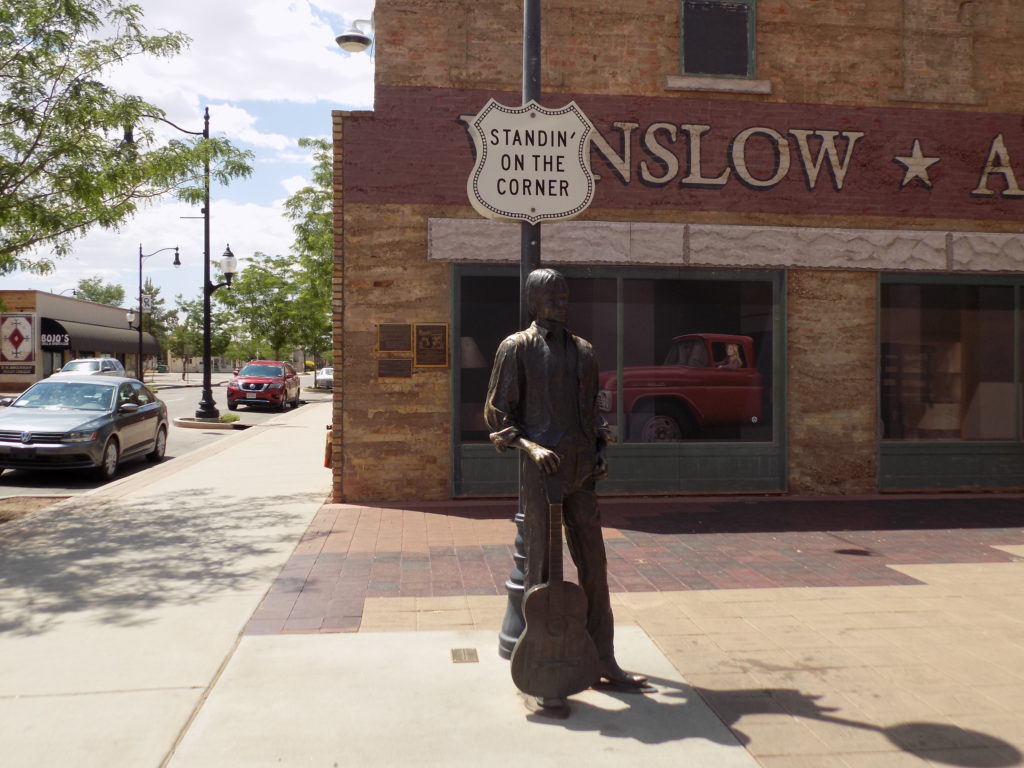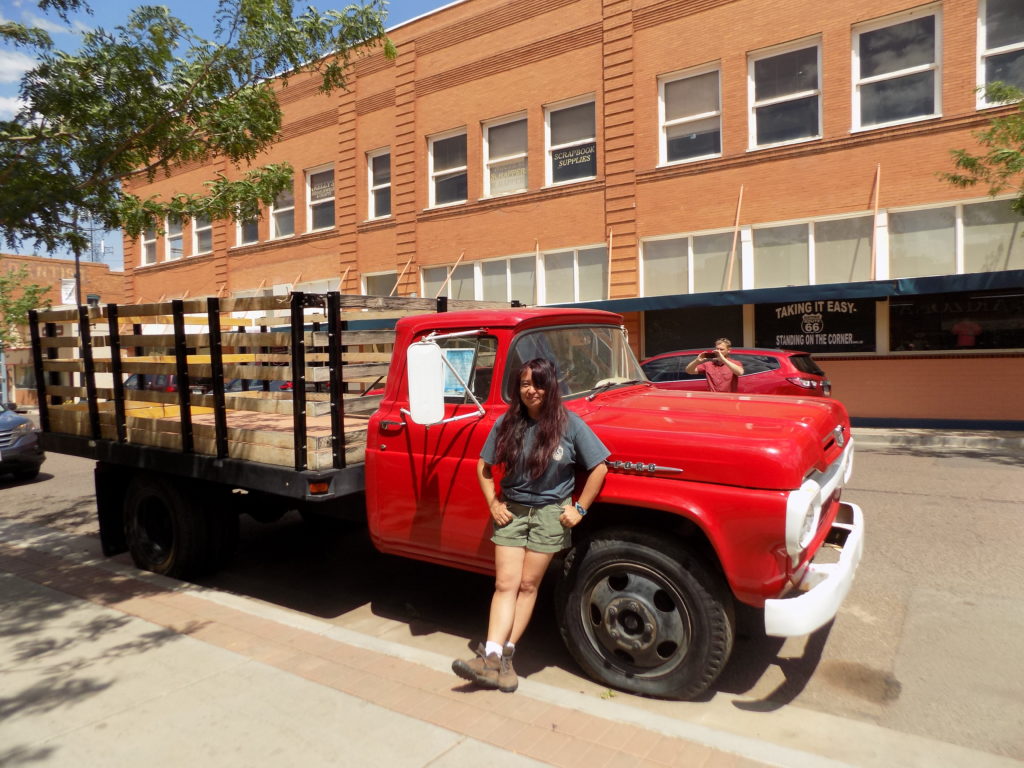Taking it easy.
Believe it or not, I’d accomplished two (visiting Walnut Canyon and Lowell Observatory) of the three main items on today’s to do list and it was barely 13:00. I took an easy drive down Mars Hill Road onto Santa Fe Avenue and was forced to turn right onto Milton Road which, it just so happens, is one stretch of Historic Route 66 in Flagstaff. Unfortunately, there weren’t many fine sights to see but, after another right turn, I did pass the Galaxy Diner across the street from the abandoned Sno Peak Inn. I planned to return there for a photo-op because I’d read the diner was a nighttime neon spectacular.
I continued on 66 for another few miles and, remaining suitably unimpressed, made a U-turn, headed back to Milton Road, and then onto the junction with I-40 East.
Just nine miles on, there’s the exit for Walnut Canyon. Hello and goodbye.
There’s the sign for Winona. I looked Winona up last night. There aren’t many fine sights to see there either. So, since I’d snapped a picture of the sign thereby following Bobby Troup’s instruction not to forget it, I’d come no closer to it. Even Google maps seemed a little unsure of how to provide directions to Winona. So, I’ll keep running down the road.
Next up is the abandoned Twin Arrows Trading Post. I’ll pull over and take a picture.
One might guess that when The Twin Arrows Resort and Casino
opened on the highway’s westbound side, it played a major role in contributing to the demise of the trading post. But that would be an assumption and we’ve already taken a (Benny Hill inspired) look at what happens when we assume. The casino and resort opened in 2013 and the deterioration on the trading post suggests that it was abandoned long before 2013. (Internet photos show graffiti indicating that its abandonment, indeed, predates the casino.) Since I didn’t make an unsupported assumption, I hope no one wants to stone me.
The Meteor Crater Road exit is another familiar ramp and another place I’ve been. Even though I may never be here again, there’s no need to stop. These were the thoughts echoing through my head as I cruised along at 70 miles per hour. Maybe I was letting the sound of my own wheels drive me crazy.
Okay. I’ll stop. I’d guess by now that everyone of a certain age or who is a fan of seventies L A country rock has tired of my none-too-subtle hints and knows that my next stop is Winslow, Arizona. And those of you who are somehow unfamiliar with The Eagles classic song Take it Easy now know it, too.
Here’s an interesting (to me) question about Winslow. If you search for Winslow’s population, the answer comes to about 9,600. Then if you input Winslow into Google Earth, this is the satellite image:
If you enlarge it, you’ll see that Winslow is physically quite small – the I-40 bypass just to the north essentially encircles the entire town – and there’s really not much around it but open space. So, my first question is, was either Jackson Browne or Glenn Frey ever there or did they just choose a rural town that sings well. If you think about it rhythmically, even Flagstaff would fit.
Now, my second question is: Assuming someone – one of the songwriters – or even someone associated with the band had actually been to Winslow, was this
the corner that Browne and Frey had in mind when they made it more or less a permanent part of American popular culture? On the other hand, since the town has decided to memorialize the corner like this,
the question is more or less moot. It is the “corner in Winslow, Arizona.”
And, the fact that there is a Standin’ on the Corner Park, is probably a good thing for Winslow. Construction began on the I-40 bypass in early 1978 and was completed soon thereafter. At that time, only Williams and Winslow remained on the as yet non-decommissioned Route 66. For nearly two decades after the completion of the bypass, Winslow, like so many towns that had thrived along Route 66 began to wither – perhaps suffering more than most. According to the Standin’ on the Corner Foundation’s website, “Until the 1960s, Winslow was the largest town in northern Arizona.” That’s certainly not the case today. By population, Flagstaff is nearly seven times the size of Winslow. Even Kingman is three times as large.
It took the town’s citizens awhile but they began to lay a roadbed and pave the road to recovery. In 1994, they disbanded the La Posada Foundation that had been established to revive its namesake hotel for one with a broader mandate and formed the Standin’ On the Corner Foundation. Even with this new focus, their first order of business wasn’t the creation of the park but remained the hotel’s restoration. The original La Posada Hotel served the railroad that passed through Winslow. It was a Harvey House hotel and was designed by Mary Colter – whom we met at the Grand Canyon.
Once they had secured a commitment from investors to restore the hotel, they began work on designing the park and it opened officially in September 1999. Slightly more than five years later, in October 2004, the building behind the statue of Glenn Frey (which was added after his death in 2016) caught on fire. The facade remained and it was restored and improved with the mural you see in the photo.
As for me that Sunday afternoon, when I was Standin’ on the Corner
I looked up and, my lord, there was a girl by the flatbed Ford.
(Actually, the picture was the result of a happy coincidence and she was nice enough to hang out while I took her picture. The first photo in this sequence is the only one from this trip in which I appear.)
It was Sunday, so the souvenir shop that you saw in the first photo on the opposite corner was open but not much else. I ambled a block or so down the street to find Las Marias very much a small-town Mexican restaurant. However, if I hadn’t forgotten what I’d eaten for lunch by the time I was headed back west on I-40, I certainly have by now. You’ve already seen most of the photos I took in Winslow but there are a few others here.
Pinballing back west on I-40, I began to feel a bit like a commuter. Everything seemed familiar and ordinary. I checked into the motel (the Little America Inn near I-40), had a much-needed shower (remember there’d been no hot water in Williams) and a bit of a rest. (The place was fine but, had my pre-trip research been better, I’d have stayed at either the more historic Hotel Monte Vista or Hotel Weatherford in the renovated Railroad District. Both are just a block or so from the stretch of Historic Route 66 that bisects downtown Flagstaff.)
After my rest, I drove the two miles to downtown and parked in the lot by the Visitor’s Center which is in the old train station on Historic 66. As has become my practice since losing my camera at a dinner in Budapest last year, I left my camera in the hotel room forgetting that I’d wanted to take a nighttime picture of the Galaxy Diner.
I wandered around a bit and was struck by the abundant wall murals that made a memorable visual impression. Since the pictures I take are more for you than for me, I found this website where you can have a look at some of them.
I’d made a list of places to consider for dinner and, when I wandered by one of them, the Mountain Oasis, I took it as a serendipitous signal and went in. It turned out to be a good choice and certainly the best meal I’d had to this point in the trip. It was a charming and cozy spot with surprisingly few customers for a Sunday evening. I had the blackened cod salad with a cup of tomato vegetable soup. The meal stood out enough that I don’t remember the beer I had. (It might have been a Guinness Extra Stout.)
After dinner, I walked around town a bit more before waddling back to the hotel to put together my notes from the day and make my final decisions about tomorrow’s adventures.






